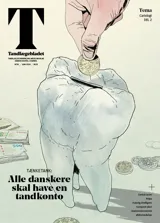Komposit plast og glasionomercement som fyldningsmateriale i permanente molarer
Denne artikel fokuserer på relevante egenskaber af plastiske restaureringsmaterialer, som understøtter deres indikation og ydeevne i posteriore tænder.
Fyldningens holdbarhed afhænger af tandlægens arbejde samt en række risikofaktorer hos patienten, som fx cariesaktivitet, tilstedeværelse af parafunktionelle orale vaner, parodontale og/eller systemiske sygdomme. I det posteriore område holder store fyldninger i molarer og/eller tænder med endodontisk behandling kortere. De hyppigste årsager til omlavning af plastfyldninger er caries i tæt relation til fyldningen eller fraktur af plastmaterialet, mens det for glasionomercementfyldninger er fraktur eller slid af materialet. Denne artikel fokuserer på relevante egenskaber af plastiske restaureringsmaterialer, som understøtter deres indikation og ydeevne i posteriore tænder. Desuden gennemgås de væsentligste trin i restaureringsteknik med henblik på at minimere fejl, som kan nedsætte fyldningens holdbarhed.
Klinisk relevans:
Valg af korrekt restaureringsmateriale egnet til opgaven samt omhyggelig udførelse af fyldningsteknik er nødvendigt for at forlænge fyldningers holdbarhed.
Composite resin and glass ionomer cement as filling materials in posterior molars.
The longevity of restorations is dependent not only on the dentist’s work but also on patient-related risk factors, such as caries activity, presence of parafunctional oral habits, periodontal and/or systemic diseases. In the posterior region, large restorations in molars and/or teeth with endodontic treatment have reduced longevity. The most common reasons for replacement of resin composite restorations are caries near the restoration or fracture of the composite, while fracture or wear in the material are frequently reported for glass ionomer cement restorations. This article focuses on relevant properties of direct restorative materials, which support their indication and performance in posterior teeth. Furthermore, the relevant steps in the restorative technique are discussed in order to minimise errors that may reduce the restoration’s longevity.


